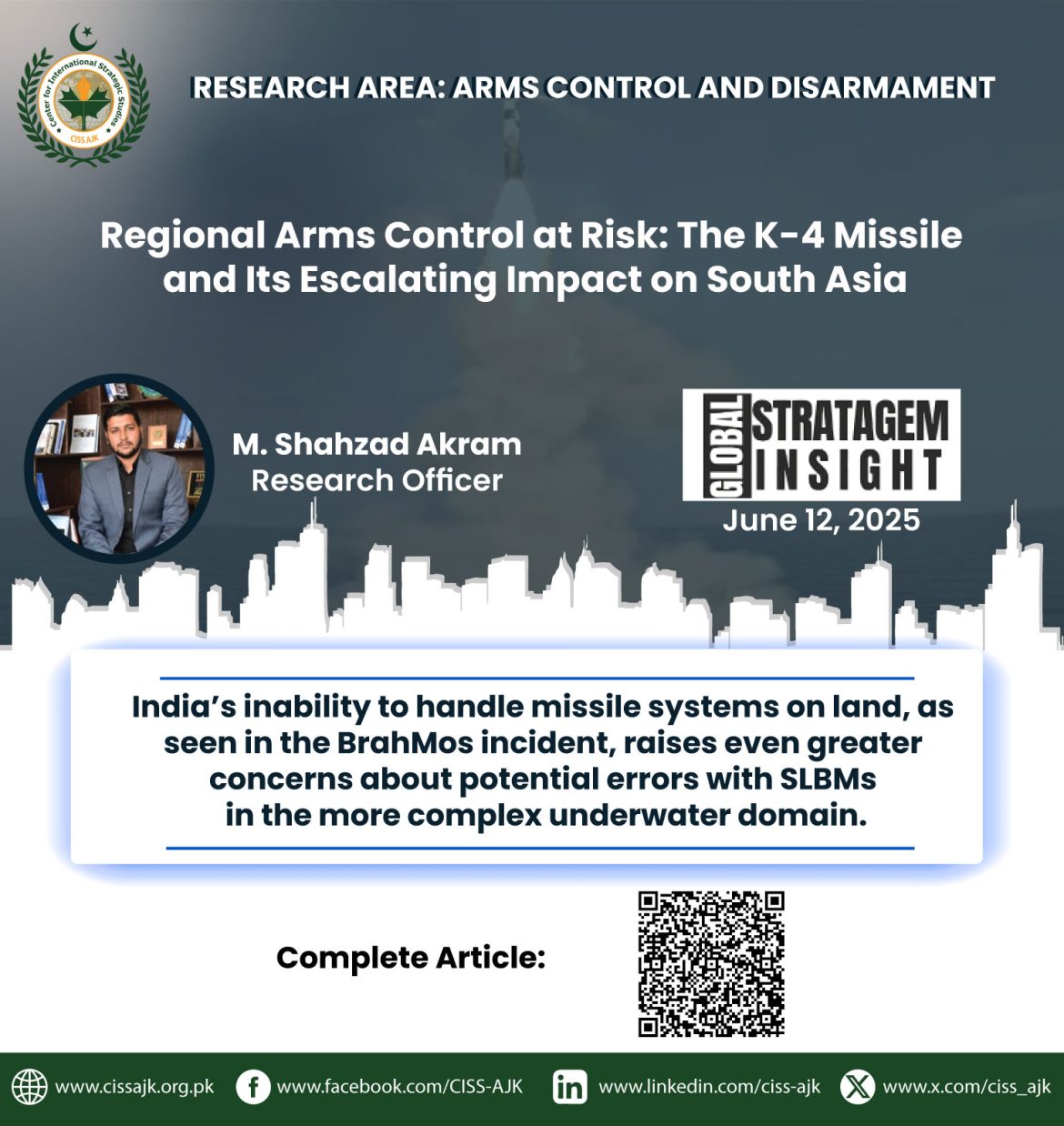An illustration highlighting the K-4 missile alongside key military assets, symbolizing the intensifying arms buildup in South Asia.
The K-4, also known as Kalam-4, is an intermediate-range submarine-launched ballistic missile (SLBM) developed by India’s Defense Research and Development Organization (DRDO). Designed for deployment on nuclear-powered submarines, the K-4 allows India to maintain a credible second-strike capability. Its range is Approximately 3,500 km, with operational flexibility exceeding that of its predecessor, the K-15 missile, which had a range of only 750 km. The K-4 is about 12 meters long and has a diameter of 1.3 meters, weighing nearly 17 tons. It can carry a warhead weighing up to two tons. It utilizes an inertial navigation system complemented by GPS/NavIC satellite guidance, having a circular error probability (CEP) of less than 10 meters.
The development of the K-4 has essential implications for the South Asian region, where the strategic balance is already delicate. For Pakistan, this advancement may heighten security concerns, prompting it to accelerate its own missile and submarine programs to maintain the balance. Such developments could lead to a renewed arms race in the region, complicating efforts toward arms control and stability. Additionally, the SLBMs may lower the threshold for nuclear escalation, given the underwater challenges of command and control. Submarine-launched ballistic missiles require efficient and secure communication channels to ensure effective command and control. Any failure in these systems could lead to accidental launches (Brahmos missile case) or misinterpretations during a crisis. This necessitates high levels of accountability, robust safeguards, and well-trained personnel to avoid unintended consequences.
The K-4, with its advanced propulsion systems, accuracy, and stealth capabilities, reflects India’s growing reliance on precision-guided systems underwater, further weakening the regional deterrence. This shift symbolizes a transformation in deterrence theory, where survivability and second-strike capabilities take precedence over solely maintaining large stockpiles of weapons.
Furthermore, the advent of advanced SLBMs like the K-4 calls for increased international oversight to prevent proliferation and ensure compliance with global arms control norms. The increased militarization of maritime zones fueled by systems like the K-4 adds to the complexity of maintaining stability. This domino effect can further strain diplomatic ties and increase the likelihood of misunderstandings or unintended confrontations in contested areas.
Additionally, this development places a spotlight on regional arms dynamics. For instance, Pakistan, which has limited resources compared to India, may focus on the deployment to counter-balance India’s SLBM capabilities. This leads to an arms race, destabilizing the region further and complicating escalation control during conflicts. The security dilemma in South Asia intensifies as advancements by one country are perceived as immediate threats by the other, sparking actions and reactions that may spiral out of control.
Existing arms control frameworks between India and Pakistan are already under strain. The K-4’s introduction further frees the sea-based deterrence, undermining regional arms control efforts. At the same time, India has failed to comply with any regional or international arms control agreement. However, Pakistan’s efforts to establish multilateral and bilateral agreements to curb the arms race in the region are already stymied by great power interest. The K-4 missile could fuel skepticism over India’s commitment to arms control, especially among non-nuclear states and neighbors.
India’s growing nuclear and missile capacity needs to be addressed by the torchbearers of global stability. The intensification of the arms race initiated by India could severely impact the region and beyond. Considering the fragility of strategic fabric, the major powers and international institutes must revisit their arms control diplomacy. The U.S., in particular, should push for more transparency and peaceful solutions to long-standing issues between Pakistan and India. However, the U.S.’s nuclear posture and its alliance with India complicate regional arms control.
The K-4 missile further complicates the fragile arms control environment in South Asia by contributing to the ongoing arms race between India and Pakistan, as the K-4 will further weaken the fragile strategic stability in South Asia. These dynamics make the arms control situation in the region even more precarious and create significant challenges for arms control efforts aimed at limiting weapons and ensuring stability in South Asia. Addressing these multifaceted challenges requires a multi-pronged approach. International and regional actors must prioritize diplomatic engagement to address security concerns while fostering confidence-building measures to reduce the likelihood of armed conflict. At the same time, robust international frameworks must be developed or reformed to tackle this mounting missile race in the region.



